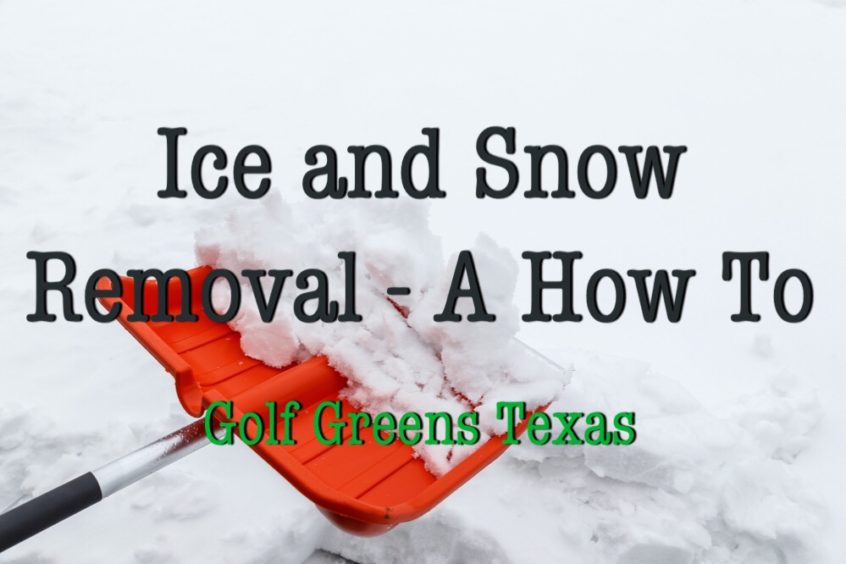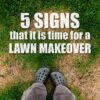In West Texas, we rarely get enough snow to require ice and snow removal. We may receive enough snow to blanket our lawns, sidewalks, and driveways or parking lots, but we do occasionally get a freak snowstorm that really piles up the white stuff.
Be prepared for the freak snowstorm this year with these Ice and Snow Removal Tips.
Use a Melter
Apply a liquid magnesium chloride blend with a garden sprayer a few hours before a storm. This will melt snow accumulations of less than 2 inches and keep ice from bonding to hard surfaces. Liquid magnesium chloride requires approximately 1 gallon for every 1,000 square feet.
Use the right kind of shovel
Look for a shovel with a lightweight plastic or aluminum blade that is coated with a nonstick finish. Avoid a blade/bucket that is too big or you’ll be tempted to overload it and injure yourself. Avoid using metal blades on softer materials like your wooden decking. A pusher shovel is useful for clearing lightweight, fluffy snow.
Don’t Wait
Shoveling is the most basic form of ice and snow removal. Shoveling should be done as soon as possible. If shoveling is too challenging for you, pay a neighborhood kid a few dollars to help.
It is recommended to shovel several times, even while it’s still storming, so that snow doesn’t get a chance to bond to surfaces. It is much easier to remove smaller accumulations repeatedly than large quantities all at once. If it is not possible to remove the snow as it is accumulating, snow should be removed in layers and before it has been packed down by vehicles or foot traffic.
Get down to the pavement beneath so that sunlight can warm it up and prevent ice from forming.
While shoveling, don’t heap up the snow on foundation walls, where melting water can refreeze and cause cracks to widen, or against anything made of wood, which is also susceptible to water damage.
Pick the right De-icer
The job of a de-icer is to loosen ice from below to make it easier to shovel or plow. Don’t pile on the de-icer thinking you’ll remove the ice completely. You won’t. The recommended application rate for rock salt is around one handful per square yard you treat. Wear gloves when spreading any deicer by hand. You can use a handheld or push spreader for large areas. Store de-icers off the floor or in a sealed bucket to keep them dry.
Types of De-Icers:
Sodium chloride — While generally the least expensive de-icing product, rock salt doesn’t work well in temperatures below 12 degrees F and can leach into the soil – changing the chemical balance to toxic levels. It is tough on grass and shrubs, and it can eat away at concrete. May contain cyanide.
Calcium chloride — Works well at temperatures below zero and is considered less harmful to vegetation. But it can leave behind a slippery residue which can be harmful to carpet, tile, shoes and your pet’s feet. This product can be up to three times more expensive than rock salt, but you don’t need to use as much.
Calcium magnesium acetate — Can cost 10 times more than rock salt, but it’s salt-free and biodegradable. It won’t harm the environment and is less corrosive to concrete than salt.
Urea — Primarily used as a fertilizer, urea has a lower potential to damage vegetation compared to potassium chloride, but it still has the potential to burn your lawn, shrubs and other plants. It can also contaminate runoff water with nitrates.
Be careful when you do use salt
5 Problems With Salt
- Excess salts build up in the soil.
- Salt residue prevents plants from absorbing moisture and nutrients.
- Salts can leach heavy metals, which eventually make their way into water supplies.
- Salt on grass or sidewalks and close to roads can attract animals, which may be hit by cars if they’re licking the salt from the ground.
- Plus, salt can burn our pets if it lodges in their paws.
Get some traction
Scatter sand or kitty litter to add traction to slippery surfaces. Choose sandbox sand over mason’s sand, which is too fine. Or try alfalfa meal, a slow-acting fertilizer that also helps melt snow. You can even use birdseed! The grains won’t melt snow or ice, but they will give you more grip on icy surfaces. Also, wear boots that have a solid toe and bottom treads to help increase your grip on icy surfaces.
Invest in a Snow Blower
A snow blower is quickest way to clear snow from a large, flat area. Use one when there’s at least 1-1/2 inches of snow on the ground. Before each use, spray the exit chute with silicone to keep snow from sticking. When you are done, let the machine run for a few minutes to dry out and to prevent parts from being damaged by freezing. If you are worried about air and noise pollution, opt for an electric model.
Try a “Snow Melt Mat”
If you’re installing a new driveway or replacing an old one, lay down electric wires to heat the driveway from below and radiate heat upwards. Never shovel snow or slip on an icy driveway again!
Use a Snow and Ice Removal Service
If the forecast calls for snow and you know you will need a clear walkway, driveway, or parking lot. Enlist the services of a company that provides Ice and Snow Removal. Please don’t wait to call the day after it snows. Most likely, the company will already have a full schedule.







